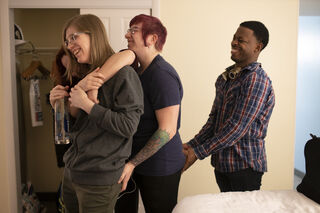Polyamory
Scenes of Mundane Polyamorous Life
The Open Photo Project depicts the regular lives of polyamorous folks.
Posted April 20, 2021 Reviewed by Gary Drevitch
When mainstream media outlets address polyamory, they often focus intently on sexuality and tend to use other, less sexy parts of poly life to set the stage for the main event. In my research, I have found exactly the opposite: Sexuality is one element of polyamorous life, but for most poly folks, their emotional and social relationships form the mainstay of daily life. Rather than a constant orgy, most polyamorous folks spend their evenings gaming, helping their kids with homework, managing the family calendar, doing dishes, or folding laundry while watching TV. They also have sex sometimes, but just as in long-term monogamous relationships, it tends to be a fun sideline instead of the primary focus of a relationship.
A new video from Erika Kapin at the Open Photo Project celebrates the daily lives of folks in polyamorous relationships with photographs and a soundtrack of the people in the photos talking about their lives. Originally envisioned as a project to help destigmatize consensually non-monogamous relationships by creating empathy, the Open Photo Project includes hundreds of photos with over 100 people in polyamorous and other forms of consensually non-monogamous relationships. Kapin also interviewed her photographees about their lives, asking about experiences with jealousy and coming out, and how their other personal identities intersect with CNM. Spurred by a desire to “confront the broad misconceptions that exist in the mainstream social landscape where monogamous is the default relationship style,” Kapin transformed her still photographs into a moving video montage. When monogamy is the default, mainstream discussions tend to present consensual nonmonogamies as highly sexualized, even if the nonmonogamous people are actually focused more intently on the emotionally intimate aspects of their lives.
Polyaffectivity
Polyamorous people are notorious for making up words to describe their experiences, because they often find that language based in monogamous culture fails to adequately encompass their lived experiences. The word polyamory itself is a construct of the community (coined by Morning Glory Ravenheart Zell), as are terms like compersion, which is the joy of seeing your partner having fun with someone else – the other side of jealousy — and metamour, to describe your romantic partner’s other partner, with whom you are not romantically involved. Spurred by this community trend in word creation, I coined the word polyaffective to describe the non-sexual relationships I noted among my research participants who shared a polycule (an extended polyamorous family connected by romantic and platonic relationships) and regarded each other as chosen family members.

My research indicates that polyaffectivity is the backbone of the polyamorous family. When the non-romantic partners support the romantic relationships in the polycule, things go more smoothly than if the non-romantic partners hate each other and try to sabotage the romantic relationships their partners have with others. Polyaffective partners provide each other with emotional and practical support over long periods of time, in effect acting like supportive family members. It might not provide the sexy drama that media outlets seek, but the ability of metamours and other polyaffective family members to coexist happily is what makes or breaks a poly family.
In her interviews and time spent with polyamorous families, Kapin noticed that “while romantic and sexual relationships may shift in polyamorous relationships (just as they do in monogamous ones), these intentional family connections often create a rich network of community support and care which thrives over time.”
Polysexuality
Even with the strong emphasis on emotional connection and family building among polyaffective partners, it is undeniable that sexuality is a part of many (but not all) polyamorous people’s lives. In my own research I tend to focus on the social, domestic, legal, and economic interactions in polyamorous families, including discussion of sexuality as it is relevant to family life.

Kapin was also initially reluctant to focus too much on sexuality, but eventually came to realize that “it is also important to recognize our intimate moments as well as the more mundane daily activities in order to share a deeper view of our lives.” While the Open Project includes images of intimacy, none focus on active sexuality in a way that would come across as pornographic. Instead, they depict the beauty of mundane life among polyamorous folks who are living their dreams of consensually nonmonogamous relating.


